Craft Your Zen with Bonsai on Minimalist Shelves****
Integrating bonsai into minimalist shelves can be an artful journey.
I remember my first Ficus, an unassuming little tree that somehow transformed my living space. It became a symbol of patience and balance—just like the trees that thrive in nature. At Silent Balance, we explore the beauty and symbolism of trees, showing how they can ground your home.
Choose sturdy species like Ficus or Chinese Elm.
Opt for simple, neutral pots; let them humbly complement your décor.
Ensure your bonsai gets adequate light and airflow.
Each tiny leaf holds its own story—nurtured with care, they evoke warmth and tranquility.
One evening, while watering my Bonsai collection, the soft glow of the sunset filled the room.
The trees, with their graceful shapes, whispered tales of resilience and growth.
In that moment, I realized that bonsai aren’t just decor; they’re living reminders of life’s endless possibilities.
Let your bonsai do the talking.
Choose the Right Bonsai Species
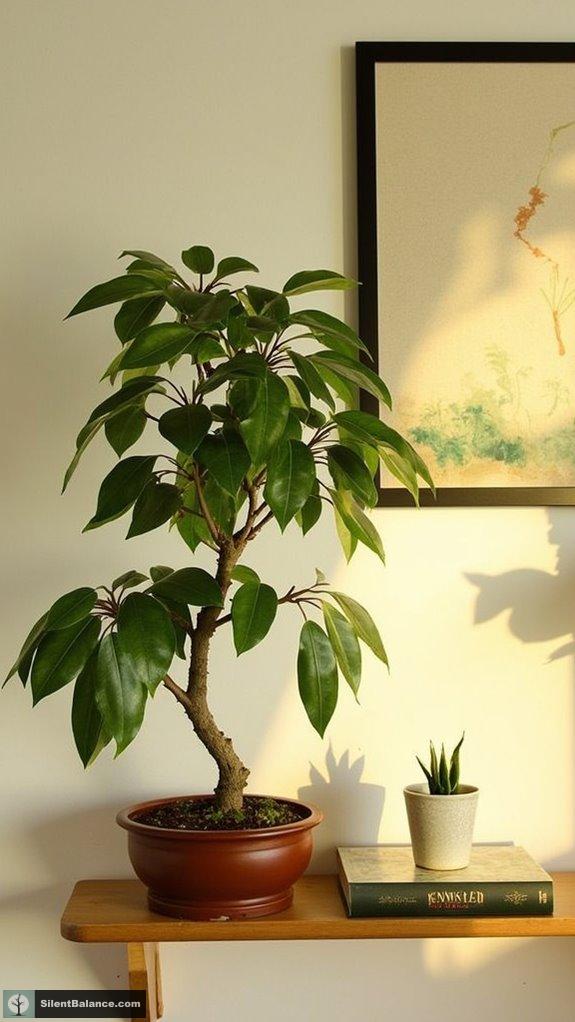
When it comes to choosing the right bonsai species, how do you even begin to sort through the leafy jungle of options?
First, I’ve found Ficus species, especially Ficus retusa, to be a superb choice. They thrive in indoor conditions and shrug off low humidity like a boss. This resilience makes them a popular choice for beginners who are just starting their bonsai journey.
Then there’s the Chinese Elm, which adapts beautifully and flaunts a vigorous growth pattern—perfect for those mastering clip-and-grow techniques.
Don’t overlook Dwarf Jade and Fukien Tea; their compact stature is excellent for minimalist aesthetics. Additionally, it’s crucial to consider that tropical and subtropical trees adapt well to indoor environments, allowing you to enjoy a thriving Bonsai display year-round.
Select Simple, Neutral-Colored Pots
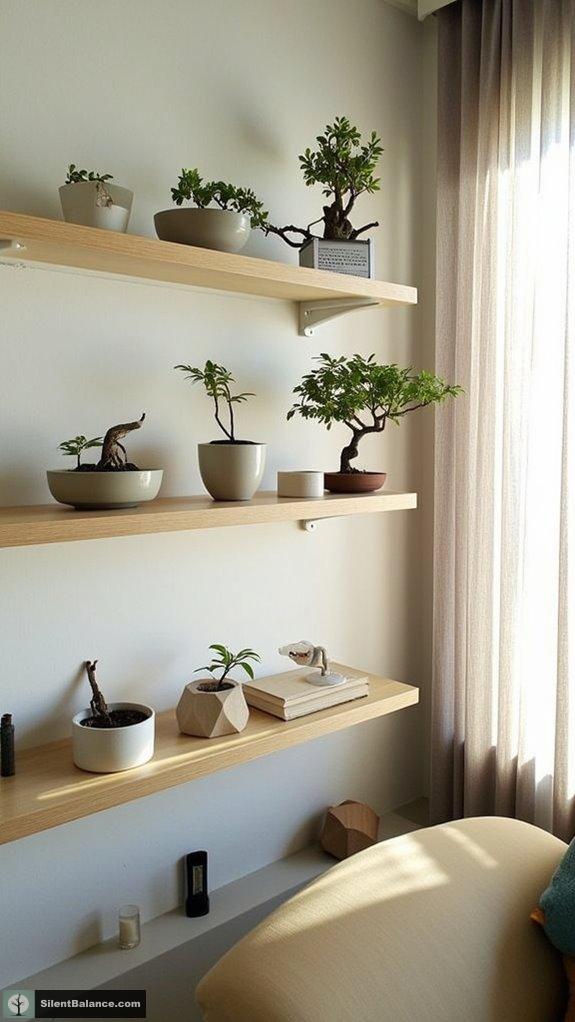
Choosing the right bonsai species lays a solid foundation for your indoor jungle, but let’s not overlook one of the most impactful aspects of your bonsai’s presentation: the pot.
Opt for simple, neutral-colored pots—think whites, grays, or taupes—that blend seamlessly into the background. Avoid those flashy, patterned options that scream for attention.
Focus on pot dimensions that complement your bonsai’s shape, too; harmony is key. Handmade ceramic bonsai pots are an excellent choice for those seeking a unique yet understated look.
Geometric designs with thin rims will keep it sleek. You want your bonsai’s elegance to shine, not be overshadowed by its vessel, right?
Position for Optimal Light Exposure

To truly make your bonsai thrive, how you position it for light exposure is just as essential as choosing the right pot.
Carefully evaluating window orientation is crucial; I find south-facing windows are golden! You want your bonsai soaking up bright, indirect light for 4-6 hours daily—no sunburned leaves, please!
Consider using a light meter for precise light measuring.
Keep in mind to adapt your shelf placement seasonally; that sunlight angle changes! In winter, be mindful that your bonsai may require less water due to reduced growth and evaporation rates.
Keep your bonsai within 1-3 feet of the window, and don’t forget reflective surfaces to amplify that glow!
Isn’t it exciting to watch your bonsai flourish under the perfect light?
Maintain Air Circulation Around Bonsai
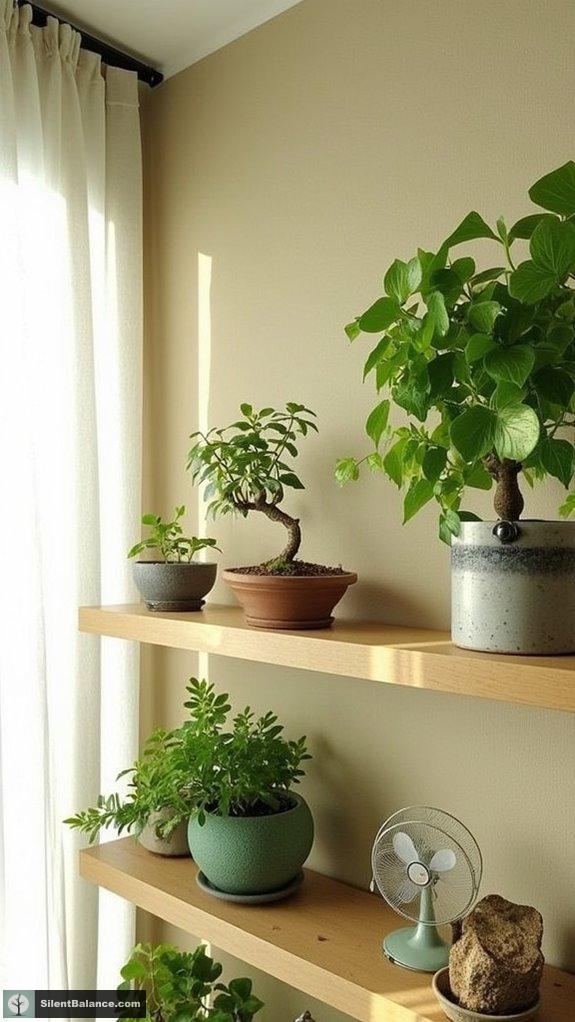
How do we guarantee our bonsai breathe easy and thrive like little green warriors in their minimalist shelves?
By embracing airflow techniques and innovative ventilation strategies!
I always position my bonsai with a small gap between the pots and back surfaces, ensuring air can dance freely.
Using tiny, whisper-quiet fans creates a gentle breeze without turning my leafy friends into cacti.
Avoid glass terrariums—they’re air prisons!
Regularly prune and rotate your bonsai, promoting airflow through dense foliage.
And hey, don’t forget to clean those shelves; dust is like a party crasher, blocking the good air your bonsai crave!
Let’s keep our greens happy!
Use Minimalist Decor Elements
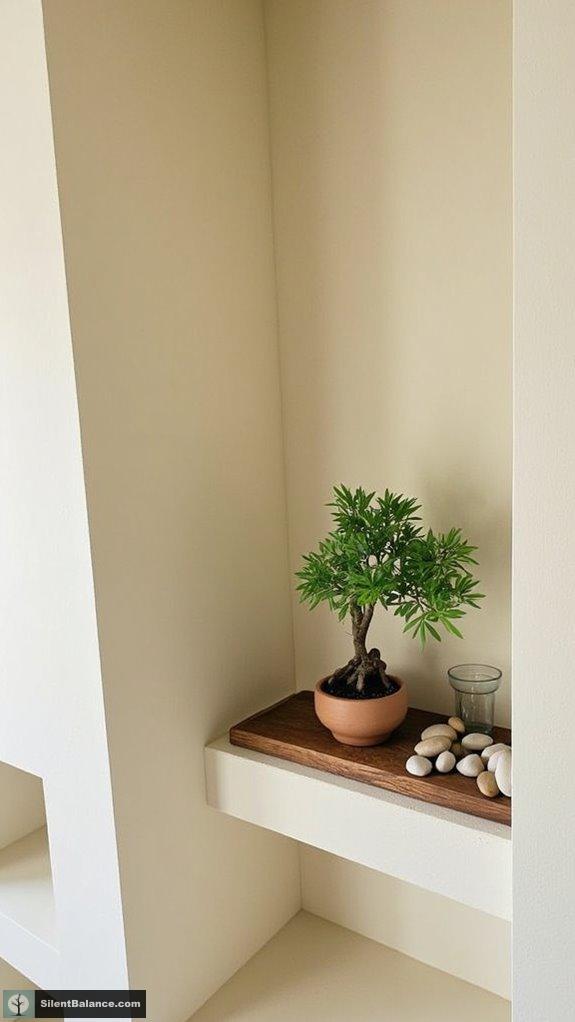
When you embrace minimalist decor elements, you’re not just organizing space; you’re crafting a serene stage for your bonsai to shine.
Think neutral color palettes—soft whites, beige, and earthy tones create a calm backdrop. This sets your bonsai’s lush greens ablaze, elevating it to center stage without any visual drama.
Clean, geometric lines in your shelving? Yes, please! They amplify order and let your bonsai’s artistic form breathe.
And recall, each decor piece should have a purpose—it’s all about decluttering techniques.
Simplicity is your best friend, ensuring that every element contributes to an atmosphere of tranquility and mindfulness.
Ready to innovate?
Create Visual Balance on Shelves
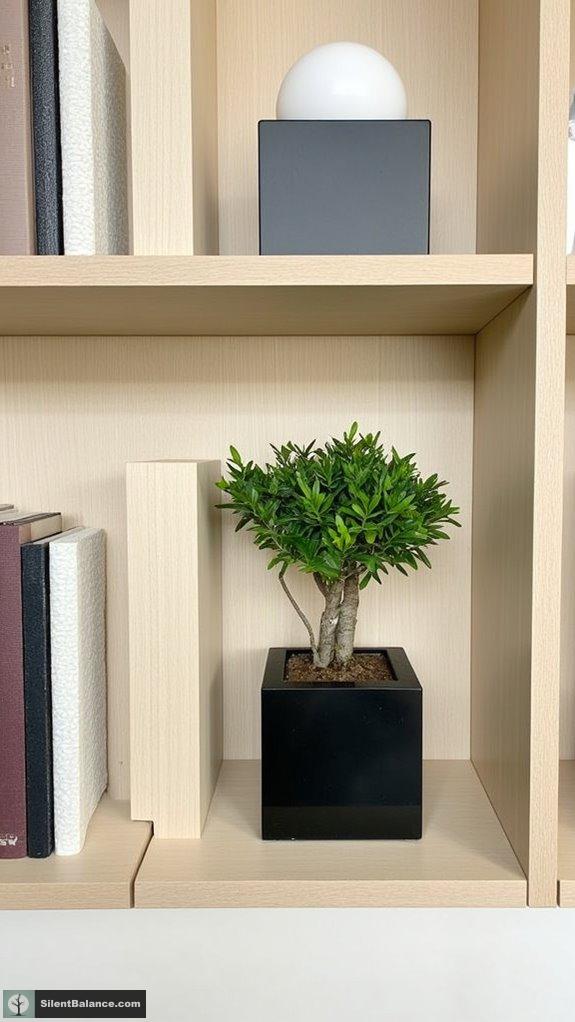
Minimalist decor sets the perfect stage for bonsai, but let’s take it a step further by creating visual balance on our shelves—after all, that’s where the magic happens!
Consider how visual weight plays into shelf symmetry. I love placing medium-small bonsai at the center, where their subtle textures stand proud against smooth shelves.
Try pairing them with contrasting elements, like geometric shapes, to keep things lively.
Don’t forget the power of spacing; intentional gaps highlight your bonsai, giving them room to breathe and shine.
Are you ready to transform your shelves into a harmonious oasis? Let’s do this!
Incorporate Height Variation on Shelves
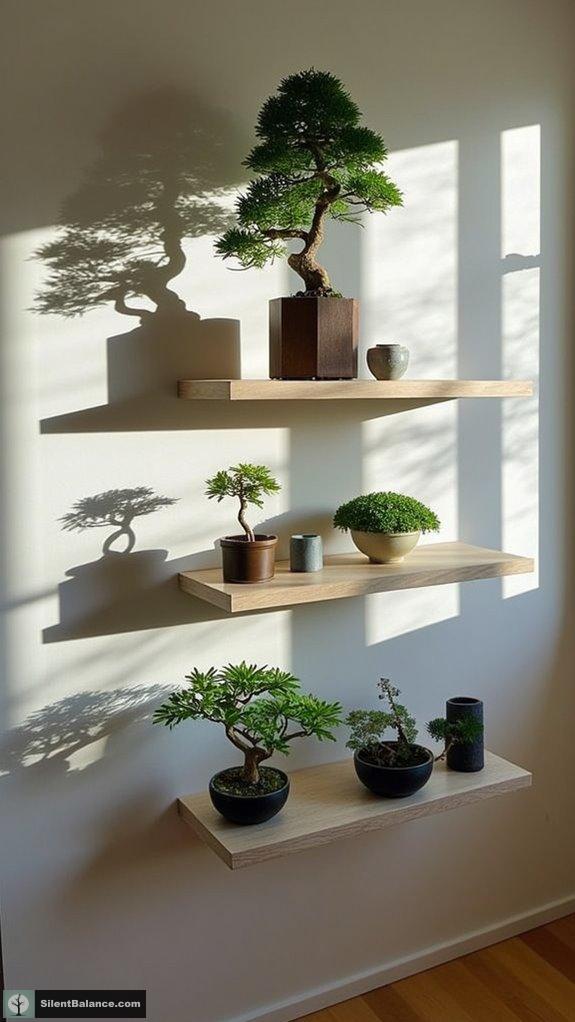
Incorporating height variation into your bonsai display can transform your shelves into an enchanting visual experience, especially when you ideally arrange the trees within the given space.
Consider using multi-tiered shelving—it’s a game changer!
By mixing height grouping for your bonsai, you create that eye-catching tiered composition.
Imagine a cascade bonsai perched proudly on a pedestal, while smaller shohin varieties dance below.
Staggering tree heights adds depth and keeps monotony at bay.
Arrange Bonsai as Focal Points
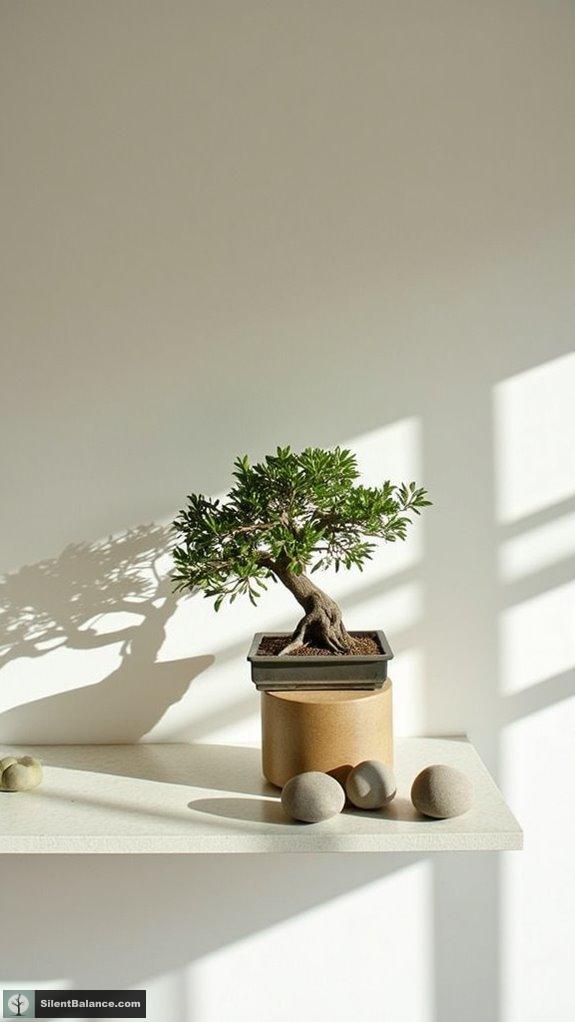
Arranging bonsai as focal points can turn an ordinary shelf into a stunning visual masterpiece, right before your eyes.
Think about it: selecting a quirky wind-swept shape for maximum impact.
Place it at eye level on a sleek stand; this is where shelf spacing works its magic!
Keep the surrounding decor minimal, maybe just a subtle stone or two, so it doesn’t compete.
And don’t forget: rotating your bonsai keeps the visual feast fresh!
Trust me, this focal point arrangement will draw admirers and spark conversations.
Who wouldn’t gawk at your botanical star?
Ensure Adequate Watering and Humidity

When you immerse yourself in the world of bonsai, it’s not just about sculpting those stunning miniature trees; you’ve got to keep an eye on their hydration game too!
Understanding your bonsai’s species-specific watering needs is essential; for instance, a Fukien Tea loves moist soil, while a Ficus can be a bit of a drama queen with waterlogging.
Master your bonsai’s unique watering preferences—Fukien Tea enjoys moisture, while Ficus can be sensitive to excess water.
Embrace innovative watering techniques, like consistently checking soil moisture with a chopstick.
Don’t forget humidity control—place a pebble tray beneath your bonsai to keep those moisture levels ideal.
With a little attention, your minimalist shelves can showcase thriving greenery, making your space feel alive!
Regularly Prune and Maintain Bonsai
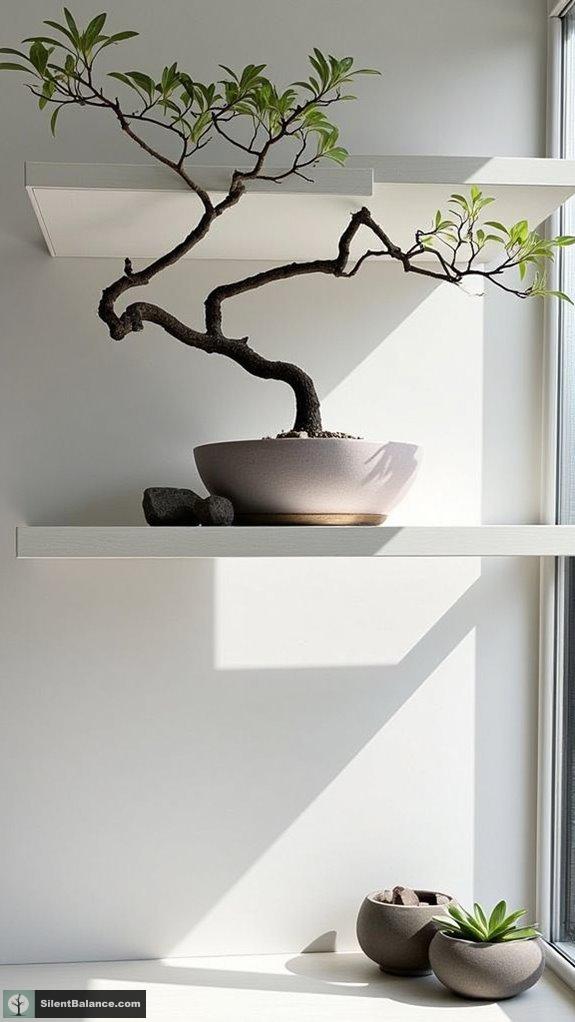
Pruning your bonsai isn’t just a chore; it’s an art form that lets you connect intimately with your little green masterpiece!
With the right pruning techniques, I’m able to elevate my tree’s design and health. I stick to a maintenance schedule, trimming small shoots regularly while timing structural pruning during those sweet early spring or late fall months.
Using sharp, sanitized shears, I’ve learned to embrace the natural growth patterns of my bonsai. Trust me, results speak volumes!
Bonsai Tree Symbolism
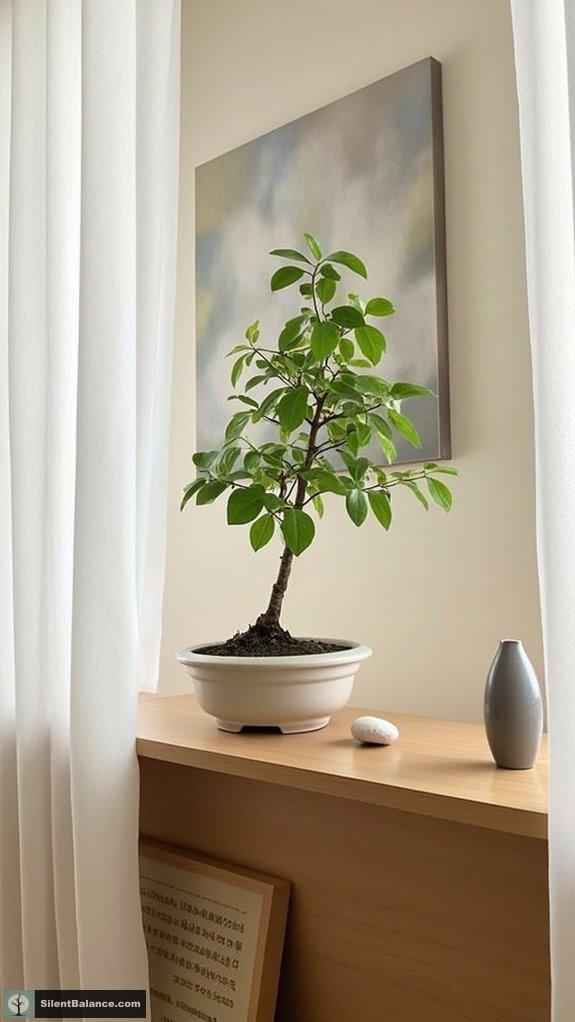
Bonsai trees are more than just elegantly pruned plants; they’re living symbols steeped in history and meaning.
These miniature wonders represent harmony, peace, and the delicate balance of nature, making them perfect for minimalist shelves.
Bonsai trees embody harmony and peace, bringing a touch of nature’s balance to your minimalist decor.
Their cultural origins, tracing back over a millennium, illustrate refined artistic expression and spiritual balance.
Ever thought about the symbolic meanings behind each species?
Like azaleas, which embody gentle beauty and love.
These living companions teach us patience and mindfulness in our fast-paced world, inviting us to slow down, reflect, and appreciate nature’s simplicity amidst life’s chaos.
Why not let a bonsai inspire your space?
Questions and Answers
How Often Should I Water My Bonsai on Minimalist Shelves?
Wondering how often to water my bonsai? I’ve discovered that watering frequency hinges on moisture retention, tree species, and pot size; daily checks help me adapt, ensuring healthy growth without stress or surprises.
Can I Use Decorative Pebbles With My Bonsai?
Yes, I love using decorative pebbles! They enhance bonsai aesthetics by adding texture while helping retain moisture. Just make sure they don’t block drainage holes; my bonsai thrive beautifully with this innovative touch on display.
What Types of Bonsai Are Best for Low-Light Conditions?
If you’re looking for the best bonsai varieties that thrive in low light, I swear by ficus, jade, and Carmona! They’ve got incredible low light adaptations and bring life to any dim corner effortlessly!
How Do I Prevent Dust Buildup on Bonsai Leaves?
I prevent dust buildup on my bonsai leaves by regularly leaf cleaning and maintaining ideal humidity levels. This keeps the leaves healthy, reduces dust stay, and enhances their aesthetic appeal in my living space.
Is It Okay to Place Bonsai Near Air Conditioning Vents?
I wouldn’t recommend placing bonsai near air conditioning vents. The climate impact can jeopardize bonsai health due to moisture loss and temperature fluctuations. Instead, find a spot with stable conditions for thriving growth.
References
- https://www.youtube.com/watch?v=kX3XNdR00J4
- https://www.allthingsbonsai.co.uk/bonsai-tree-care/indoor-bonsai-care/
- https://www.backyardboss.net/bonsai-basics-caring-for-a-miniature-tree/
- https://www.jacksonandperkins.com/how-to-care-for-bonsai-tree/a/how-to-care-for-bonsai-tree/
- https://www.bonsaibaime.com/bonsai-tree-after-care
- https://www.bonsaiempire.com/tree-species/indoor-bonsai
- https://www.lovemybonsai.com/blogs/bonsai/7-indoor-bonsai-trees-that-thrive-in-low-light-environments
- https://www.youtube.com/watch?v=0gKgraG1PAE
- https://easternleaf.com/indoor-bonsai-trees-s/547.htm
- https://forum.bonsaimirai.com/t/best-trees-for-indoor-bonsai/11363
- Blend Vintage and Modern Decor With Bonsai - September 25, 2025
- Bonsai and Decor: Living Room Design Ideas - September 25, 2025
- Asian-Style Bonsai Displays With Traditional Decor - September 25, 2025

